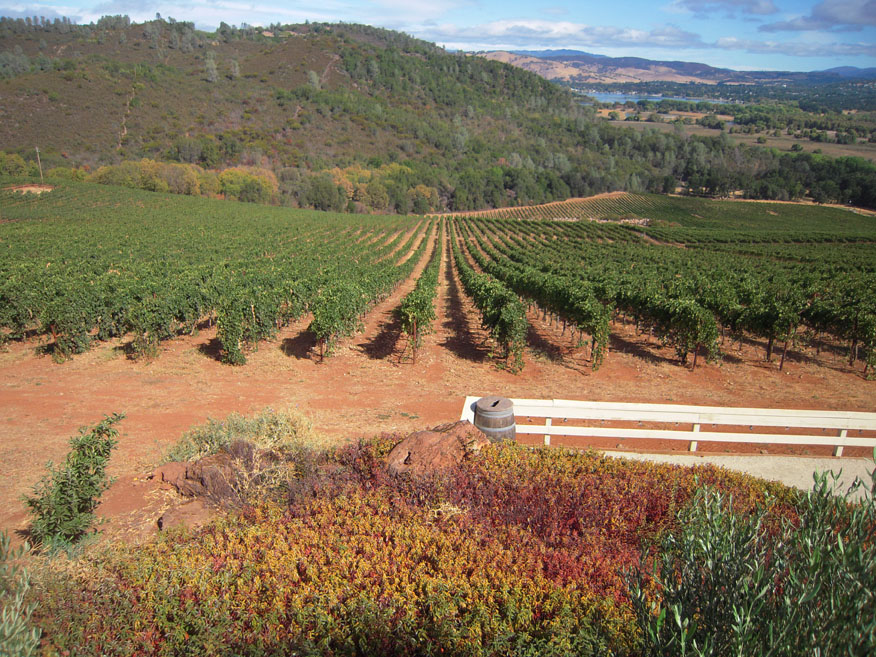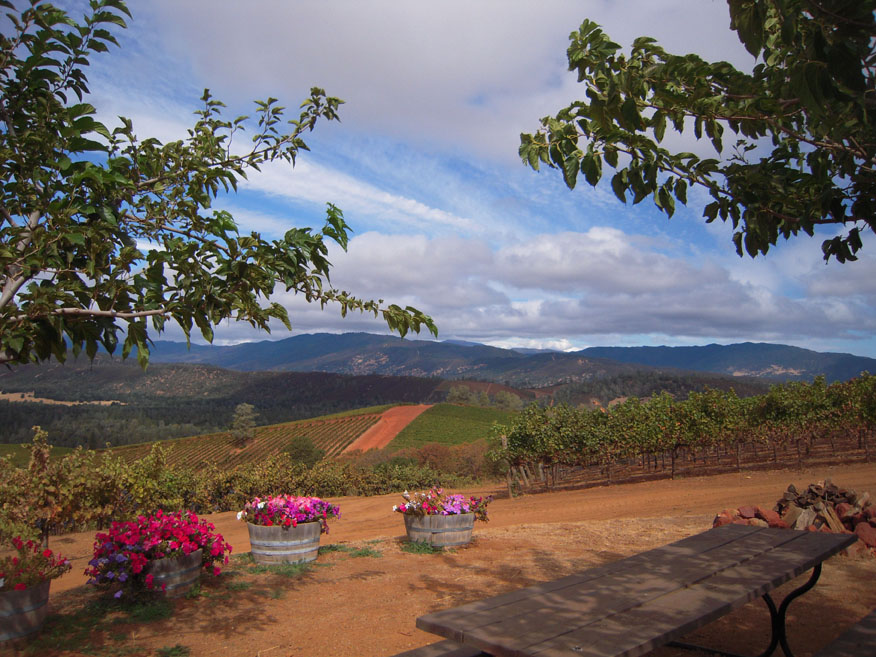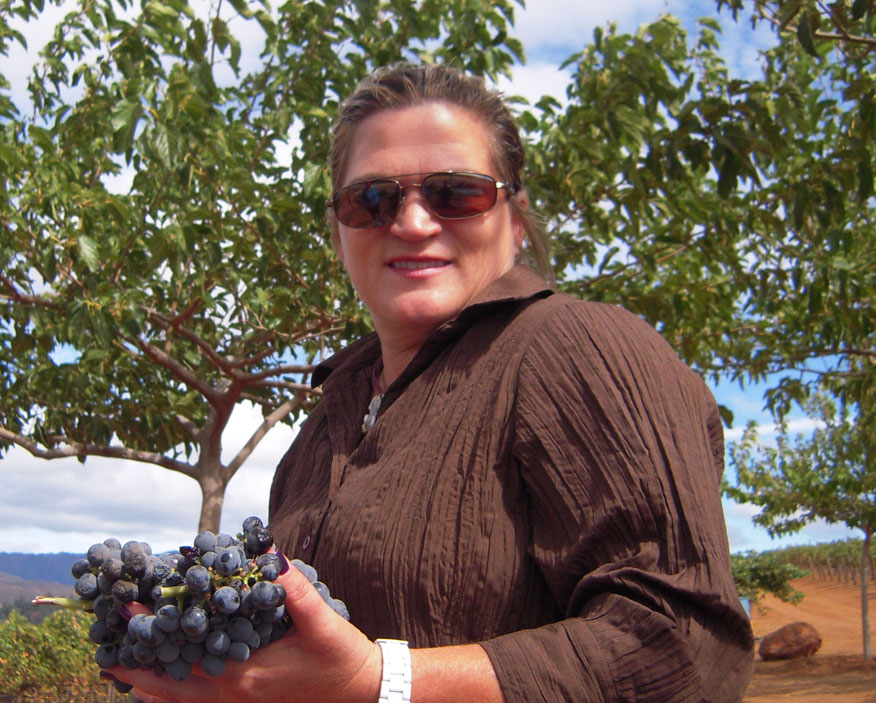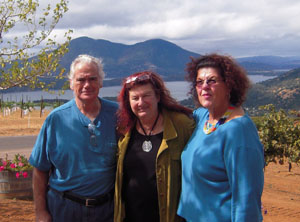We visited Lake County’s Shannon Ridge Winery at the end of September, at the near completion of the grape harvest. The prediction is that this year will be a stellar harvest. Lake County vineyard owners started their harvests as much as 10 days earlier than last year due to dry, warm conditions, as well as the grapes’ early ripening.. A very warm spring and an early-onset summer prompted decisions to start picking earlier than usual. The quality of the grapes this year will be similar to that of 2013; however, the drought will undoubtedly affect the quantity.
There are 300 beautiful, scenic acres in the lower-altitude Red Hills AVA (“American Viticulture Area”), overlooking Clear Lake. The soil you see is volcanic soil. It appears redder than other soil, and characteristically does not hold water, which causes the vines to be more deeply rooted.
There are 1,800 acres on the other side at High Valley AVA (at altitudes of 1,200-1,400 feet), which, surprisingly enough, was once a lake! The climate is cooler, dry and warm but with breezes and cooler nights. The deeper roots bear good fruit and don’t require a lot of water.”
The winery has 2,000 acres of land, and yields 160,000 cases per year. The La Sierra Picnic Grounds offers lunches and picnic spaces. Surrounding the higher-altitude lands are three dormant volcanoes: Mt. St. Helena, Cobb, and Mt. Konocti.
According to owner Clay Shannon of Shannon Ridge Vineyards & Winery, “Our harvest this year looks great. We are very excited about the current quality that we are seeing in the tanks. The color in the reds is incredible, the flavors are wonderful, the tannins are perfect. Yields are down from the previous two years, which were both large. Our 1,000 sheep are very happy.
In other parts of Lake County, the drought demanded that more water be moved through irrigation methods, and that the dry grass be mowed in order to reduce moisture demands.
However, at Shannon Ridge Winery, where everything is sustainably harvested, grass between the vines was removed by way of the “Ovis” Cycle.Ovis is Latin for “sheep” and is a patented name and process for “Farming Cycle System,” a symbiotic relationship between sheep and grape farming, bringing sheep into the vineyard and then working them through the vines.
“Sustainability is the key to the heart of our company,” explains Tasting Room Manager and our tour guide, Marni[Johnson. “The sheep reduce the carbon footprint. They fertilize the grapes naturally-100 sheep in 10 rows will space out equally and work from shade area to shade area as the sun moves. Grape leaves provide 23 percent of the protein which is healthy for sheep.” The wool is sold, and the lamb meat is carefully butchered and sold to discerning clientele (fine restaurants, chefs, etc.). This winery is the largest in the nation working with sheep.
According to Marni, “fifty lucky bucks” sire 1,000 to 2,000 lambs each year around Christmastime, which are raised on mothers’ milk and grass, with no hormones or antibiotics (except in the case of individual sheep with illnesses, which are isolated from the rest of the flock and individually cared for).
The winery has been here since the 1980s The “Vigilance” title was given in honor of the sheep dogs, which guard and protect the sheep. Hawks also dwell on the property in hawk houses, and they help to control rodent infestation on the sustainably run property.
“Natural grapes” as those which are allowed to grow naturally, and which are hand-harvested. Grapes which are deliberately trained to grow upward in certain ways, on the other hand, are machine-harvested. The deep purple “Barbera” grapes, which are very sweet, are an example of “natural grapes.”
“The way you tell that grapes are ready to harvest is to put one in your mouth, chew it two or three times, and see if you taste any ‘green’ in the skin,” Marni explains. “If there is any ‘green’ taste in the skin, the grape is not yet ready for harvest.”
The area is a vast national forest area. “You can go all the way to Oregon from here without getting on a freeway,” Marni states. The area is also a very nature-friendly national animal habitat.
As of this date (9/24), harvest should be completed within one and a half to two weeks. It appears to be a good harvest, with average yield(or possibly slightly less than average this year, due to severe drought). “Crush” activity is going on in Kelseyville, a location away from the vineyard.
“Lake County is third in the nation for the cleanest air,” Marni declares. “The air is so clean that County residents are not required by law to have their cars ‘smogged’.”
The Tasting Room is open on Fridays, Saturdays and Sundays in the main offices, and is a “tasting paradise.” Some of the wines produced include Chardonnay, Cabernets, Petit Shiraz, Zinfandel and Zinfandel blends, and Barbera. The Tasting Room is located in the Lower Lake Red Hills AVA, and the Home Ranch is located in Clear Lake Oaks in the High Valley AVA.
The winery’s average bottle price is +/- $20, with the higher-end wines going for up to $60. “We want a high-quality product that you want to drink and share,” Marni says.
When Prohibition was enacted and the production of alcoholic beverages was prohibited in the United States, walnuts and pears were then raised on the property. The walnut trees still exist, and indeed the now nearly ripe English walnuts are placed in buckets in the Tasting Room. Wine bags are put out so that wine-tasting guests can also take some walnuts home with them. The winery also produces 500 cases of olive oil, which is sold in the Tasting Room.
Working for Shannon Ridge in a job she loves has been an ongoing educational experience for Marni. “You can never know everything about wine,” she states. “You’re always learning. Every day I learn something new.”
By Mike Walsh, Ellen Walsh, & Verah Bugbee
















